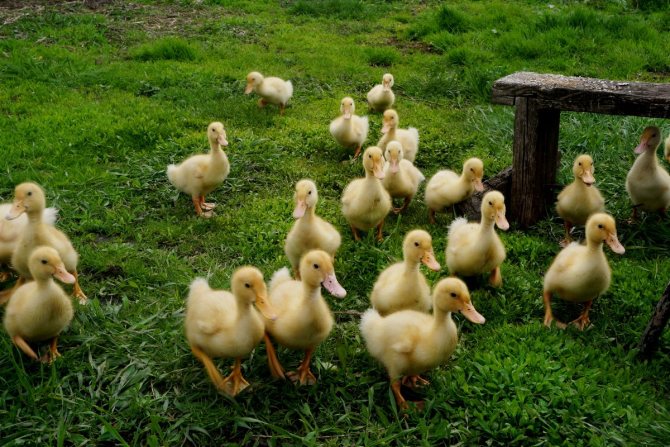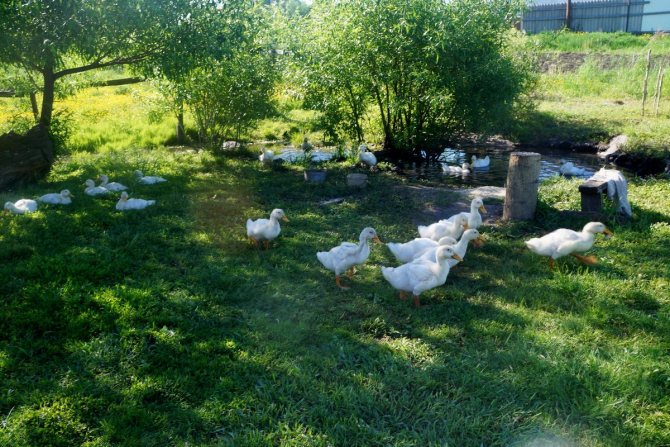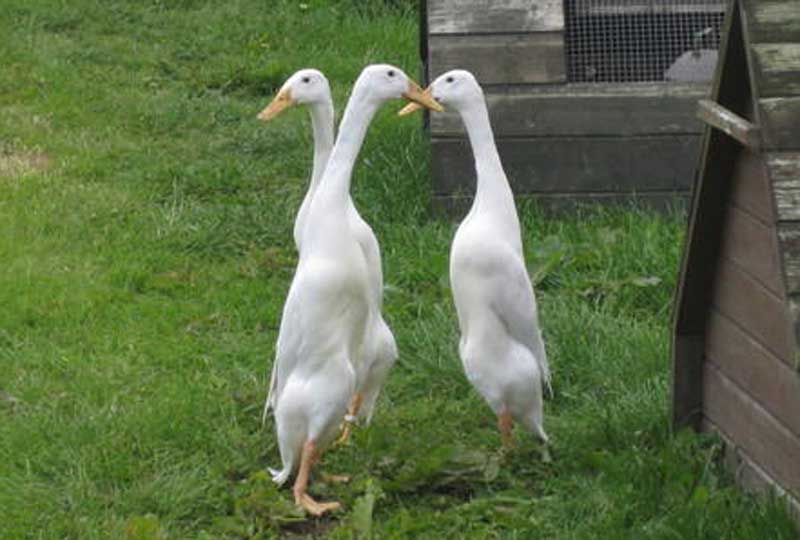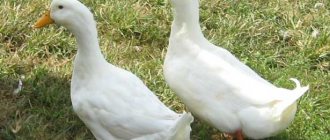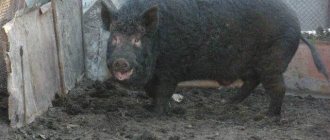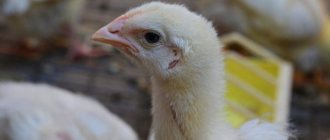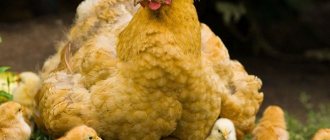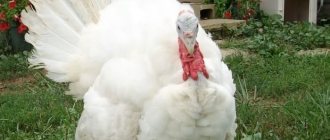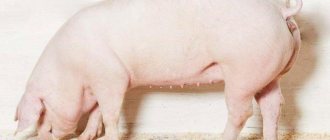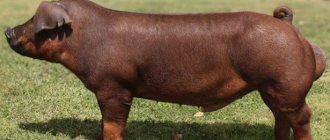From early spring to late autumn, we live in the village, which allows us not only to grow a variety of vegetables in the garden, but also to engage in poultry. In the poultry yard in the summer, we keep chickens, turkeys and broiler ducks. If you live in a village and there is a reservoir nearby in your area, then it makes sense to think about raising ducks to provide your family with fresh meat. Ducks are relatively unpretentious, independent, and the slaughter of this poultry is carried out after 2 months. I will share my experience in raising broiler ducks in this article.
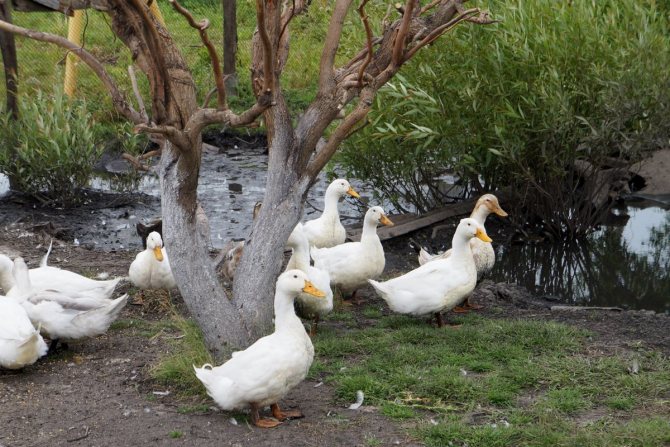
Broiler ducks are fast meat without too much hassle. <людмила>
Broiler ducks breeds
All breeds of broiler ducks are hybrid. The ancestors are the Peking and American musky duck, or Indo-duck. Both mother breeds have their drawbacks. Peking duck is too fat. In addition, these birds are voracious and noisy. Indo-women have a specific taste of meat, like game, not everyone likes it. They also do not tolerate low temperatures well. Hybrids of these breeds are partially or completely devoid of the parents' shortcomings.
The main purpose of breeding these birds was the meat direction, because broilers gain weight very quickly. Here are the most common breeds, a brief description and description:
- French mulards. To breed this breed, musky drake and Peking duck were crossed. Birds are distinguished by rapid weight gain, while they can eat any feed. Mulards are sterile, therefore, indoor and Peking are needed to breed them. These broilers are very popular in France; here bird liver is valued no less than goose liver.
- Cherry Valley. One of the most common breeds, especially in private households. Birds gain weight quickly, weighing 3 kg by three months. In addition, they lay well (up to 150 eggs per year) and give offspring, and are not sterile, like mularda. Ripen in six months, a productive duck can be kept up to 3 years old.
- Medeo. Domestic breed of broilers, which gains 3 kg in 2 months. In addition, this meat poultry produces about 150 eggs per year and reproduces on its own.
- Blagovarskie ducks. Broiler cross appeared very recently, in 1998. It is characterized by high productivity with minimal feeding costs.
- Super M. The breed gains weight quickly and its meat has excellent meat characteristics.
- Black white-breasted broilers. The breed was bred in Ukraine, its ancestor was the Peking duck, the local Ukrainian and khaki-kembel. This species is distinguished by its unpretentiousness, its maintenance is not a hassle, the birds perfectly adapt to any climate. In addition, this duck is very beautiful: a bright white chest stands out against the background of the black body.
- Agidel. Ducks are adapted to being kept in cages on industrial farms, at the same time they get well on free grazing. Their meat is very valuable, it contains many useful substances.
As you can see, there are a lot of broiler duck breeds. Some of them, like white mulards, do not give offspring. Others can be used to produce not only meat, but also eggs, and reproduction is possible even at home. How different breeds of broilers look can be seen in more detail in the photo and video. Growing all broilers has similar rules, we will talk about them below.
Features of the
If you want to increase the profit of the farm, then broiler ducks are the best option. These meat breeds of poultry are the result of many years of selection. They are highly fertile. In addition, broiler ducks grow very quickly and their meat has a wonderful delicate taste.
Broiler ducks can adapt to a wide variety of climates. In a short period of time, healthy individuals gain good weight, so many poultry breeders practice raising 2-3 broods at once.
Often broiler ducks are kept on the farm only until 7 months of age. During this period, molt of poultry begins. New feathers grow tough and dense. As a result, this can adversely affect the appearance of the finished product. In addition, by this time, broiler ducks need large amounts of feed consumed, which is why their keeping simply ceases to be economical and cost-effective.
These birds, like any other breed, need the right conditions for keeping.
They will need to equip a good poultry house, while feeding them expensive feed. If you follow all the necessary rules, then the result can be surprising in the performance of broiler ducks.
There are several varieties of these poultry. Each of them has its own distinctive features and characteristics of behavior. It is necessary to keep a particular breed based on its individual parameters and requirements.
Broiler ducks keeping
Raising broiler ducklings at home is not a very difficult process if you follow the recommendations. In order for the birds to quickly gain weight, so that they are not affected by diseases, it is necessary to properly equip the poultry house. The main requirement for a duck house is a sufficient area (if the breed is not intended for cage keeping). On 1 m² you can plant:
- ducklings from birth to two weeks - 18-20 pieces;
- from 15 to 29 weeks - 10-12 ducklings;
- adult birds - 8-10 pieces.
Before settling in a duck, the room is disinfected to prevent disease. The house should be dry (humidity not more than 75%), with a good ventilation system (6 m³ / kg of bird weight in summer and 1 m³ / kg of weight in winter). The floor is raised 15-20 cm above the ground level, this improves hygiene and prevents dampness. The floor is sprinkled with fluffy lime (0.5 kg per head), which protects against microbes, reduces moisture, then a layer of peat is placed, and a layer of straw is placed on top. One bird per year will need about 10 kg of litter.
It is very important to maintain a normal temperature in the duck room from the first days. In the first 2 weeks of life, chicks need a temperature of 26-28 degrees, then it is reduced to 18-20 degrees. Lighting in the house with ducklings of the first week of life should be around the clock. They are afraid of the dark and can pass each other with fright. In the second week, the duration of daylight hours is gradually reduced to 16-18 hours, from the third week - to 10 hours.
Broiler ducks feeding
Proper feeding of broilers allows them to grow up full-fledged birds for slaughter in a short time. On average, it is profitable to keep a duck for up to 3 months. Further, the consumption of feed increases sharply, and the weight is added much more slowly. At home, grain and other natural foods are most often used. On industrial farms, feed is preferred.
In the first week, ducklings are given boiled eggs, cottage cheese, porridge, and chopped greens are gradually added. Then they gradually add grain and legumes to the diet, so that by three weeks they completely transfer to wheat, barley and corn with the addition of greens. Proteins should prevail in the diet of the first days of ducklings (up to 20%), then their amount is reduced to 10-11% of the total amount of feed. Proper feeding of adult birds at home includes:
- cereals, bran - 45%;
- peas and other legumes - 10%;
- greens - 40%;
- seashells with chalk - 2.5%;
- fish oil - 1.5%.
Gravel can be added to food mixes to help grind the grain better. You can also feed the duck with fresh food waste, vegetables from the garden (zucchini, pumpkin, cabbage).
If the birds are raised on compound feed, then in the first 3 weeks they are given a starting one, then they are transferred to the finishing one. Feeding provides for the following daily norms:
- First week - 93 g of feed (st.).
- Second week - 106 g (st.).
- Third week - 154 g (st.).
- Fourth week - 206 g (fin.)
- Fifth week - 215 g (fin.)
- Sixth week - 240 g (fin.)
- Seventh week - 252 g (fin.)
- Eighth week to slaughter - 256 g (fin.).
When breeding a large number of ducks, feeding with mixed fodder is more profitable than with grain with additives, although in the summer, when there is a garden and a pond, food can be partially replaced with herbs and vegetables, and broilers can find excellent duckweed on a pond or near a river, only in In this situation, weight gain will not be so fast, and the quality of the meat may decrease.
Cross agidel
So what is the difference between a broiler duck and a regular duck? Let's start with the fact that almost all birds in this area of productivity were obtained artificially relatively recently. Only a few hybrids were bred at the end of the year before last - the beginning of the last century. At the same time, all modern broilers in most cases were obtained on the basis of only two highly productive ducks - Peking ducks and musk ducks.
Hybrids differ from breeds primarily in that they are unable to give good offspring. Sometimes these ducks cannot even lay fertilized eggs. This is primarily due to the large weight of the drakes. It is simply difficult for such males to cover the females. But even if fertilized eggs appear in broiler nests, it will not work to get good productive young growth out of them.
Broilers are gaining significant weight. Moreover, the bones of such ducks are quite thin. As a result, their meat yield is very high. Broiler ducks usually consume more feed than simple birds. However, their meat is almost never particularly fatty. When developing new crosses, experts pay a lot of attention to this very indicator.
This high-performance duck was obtained by crossing the Super M and Blagovarsky hybrids as well as the Indian runner. Work on its breeding was carried out in Bashkortostan at the beginning of the millennium. At the moment, there are two main lines of agidel - 34th and 345th.
At the age of 60 days, this bird can reach a weight of 3 kg. At the same time, the meat of the agidel ducks, like that of the mulard, is not too fat. It is perfect for soups as well as fried or stewed dishes.
Breeding broiler ducks
As with all hybrids, broiler ducks can be problematic. For example, meat mulards are generally sterile: for 100 eggs they may have 2 fertilized ones, but healthy chicks are unlikely to hatch from them. To obtain this breed, you need a white Peking duck and a musky drake. Many poultry farmers create just such a broodstock at home, in which there are 4-5 Pekins and 1 musky drake.
There may be problems with breeding other breeds. Broiler ducks do not always retain the maternal instinct. Hatching and caring for ducklings is difficult for them, therefore it is better to hatch the young in an incubator. Sometimes eggs are placed under another duck, which has well retained its maternal qualities. Cherry Valley eggs, Peking ducks and Muscovy ducks hatch quite well.
The hatchability of ducklings in these breeds ranges from 60% to 80%. In the early days, it is very important to maintain a normal temperature in the house, at the level of 26-28 ° C. Lighting in the first week is set around the clock, then the duration of daylight hours is gradually reduced to 10-12 hours. It is important to start feeding the ducklings in the first 18 hours, sometimes they have to be taught to eat.To do this, feed the chicks on the backs, as they see moving objects better. The feeding regimen in the first week is every 2 hours, then gradually they are transferred to 6-time and 4-time feeding. Starting from the third week, food is given three times a day. The food norms for ducklings have been given above.
Varieties
There are many breeds of broiler ducks. Different individuals have different characteristics, and even their meat tastes differently.
- Beijing. If the Peking broiler duck eats properly, then in 2-2.5 months it can easily gain weight 3 kg. At about 25-26 weeks, this bird begins to produce testicles. It was this breed that was used to breed Cherry Valley broilers.
- Musky American. Poultry meat of this breed is very similar to meat belonging to wild animals. Such ducks can live without any problems and difficulties without a reservoir, but low temperatures are dangerous for them. For this reason, it is advisable to keep such birds in regions where a warmer and more benign climate remains.
- Mulard. Broiler ducks of the Mulard breed can boast of excellent performance indicators. It is a French breed that was once bred from musk birds. They are rapidly gaining serious weight, but at the same time they do not impose great demands on the feed. Mulard meat is considered healthy and dietary - it contains a small percentage of fat. It will be possible to breed such a bird exclusively artificially - females are initially born sterile.
- Medeo. If you provide the broiler duck of this breed with proper care and feed it with good feed, then it will be able to add 3 kg in weight within a month. Medeo duck produces up to 150 eggs per year.
- Blagovarskaya. These ducks appeared in 1998. They are very popular and enjoy great success among poultry farmers, as they boast an enviable fertility and a high level of productivity. Such birds gain impressive weight quickly and easily, while large costs for feed will not be needed.
- Moscow white. Birds of this breed were obtained by crossing a Peking white duck and an Indian runner. Already at the age of 50 days, these gorgeous individuals can weigh about 2-2.5 kg, which is an excellent indicator. Birds are laid with large eggs, the weight of which can reach 90 g. In one year, the Moscow white duck can carry from 120 to 150 eggs.
- Agidel. The main thing worth mentioning in the description of this bird is its unpretentiousness. Agidel develops well both in a cage and in free-range conditions. These poultry are characterized by excellent strong immunity, due to which they rarely get sick. The egg production of such ducks pleases with its indicators, and meat is considered an elite product.
- Cherry Valley. Birds of this breed grow very quickly and are distinguished by excellent meat. Cherry Valley young growth is distinguished by high survival rate. The egg production of broilers also pleases poultry farmers with their indicators.
- Star-53. This is a rather heavy variety of broiler ducks. It is characterized by strong and fast growth. The muscles in the chest area grow rapidly. The result is excellent sirloin products.
- Indian runners. In terms of egg production, Indian runners are second to none. During the year, these birds can produce up to 230 eggs. Adult males can weigh up to 2 kg. Females, on the other hand, reach 1.8-1.9 kg in weight.
Broiler ducks diseases
Many broiler ducks are susceptible to disease, which makes them difficult to raise, which is why it is so important to keep them in a clean, spacious house with good ventilation, and feed them correctly. The most common pathologies that occur in these breeds are:
- Conjunctivitis and ulcers on the mucous membranes. Pathology may be associated with a lack of vitamin A, if the feeding is monotonous, includes little greenery and root crops.
- Convulsions, slowing of the pulse.This condition is characteristic of a deficiency of vitamin E, a large amount of which is found in sprouted grains.
- Urovsky disease. Associated with a lack of minerals in the diet. Ducks begin to pluck their feathers, try to eat pebbles, sawdust and other inedible things.
- Cutickulitis. The disease, typical for young ducklings, is accompanied by diarrhea, lack of appetite, gradual exhaustion, and can lead to death. For prevention, the diet is enriched with vitamins A and PP.
- Intestinal infections. They can affect both young ducklings and adult ducks. Most often associated with violation of conditions of detention, dirty and moldy feed, stale water. For prevention, ducklings are given water slightly tinted with potassium permanganate.
- Colds and SARS. Broiler ducks can catch a cold if it is cold in the poultry house, a draft, from time to time epidemics of viral diseases arise among birds. The most common are catarrh and omphalitis.
In case of any infectious disease of ducks (intestinal or respiratory), it is necessary to immediately separate the sick individuals, disinfect them in the poultry house. Sometimes a sick duck is simply sent to slaughter. In some cases, it is necessary to destroy the entire herd. When diseases are associated with a lack of vitamins and microelements, feeding should be reviewed and adjusted, and vitamin-mineral complexes should be added to the diet.
What diseases are susceptible to?
We recommend reading our other articles
- Kostroma breed of cows
- The best varieties of black tomatoes
- Peony varieties with descriptions and photos
- Hilling potatoes with a hiller
Broiler duck breeds most often suffer from hepatitis, tuberculosis, fusariotoxicosis, hymenolepiasis, paratyphoid fever, salmonellosis. Also, with improper feeding, they can get vitamin deficiency.
Ducklings up to 30 days are prone to cuticulitis. Older individuals are also susceptible to partial blockage of the goiter, catarrh, or omphalitis.
If any sign of illness is detected, the infected individual is immediately isolated and a veterinarian is called in to diagnose and prescribe treatment.
To reduce the risk of diseases, it is worth creating good conditions for keeping the poultry (taking care of cleanliness, no drafts), making an optimal diet and doing routine vaccination for all newborns.
Advantages and disadvantages of broiler ducks
Growing any bird has its advantages and disadvantages, broiler ducks are no exception. They get good reviews from poultry farmers, but experienced farmers also note the disadvantages of breeding. The advantages of these breeds include:
- fast weight gain;
- the ability to send birds to slaughter in 60-90 days;
- good taste of meat;
- simple care and maintenance;
- no need to keep ducks near the reservoir;
- the possibility of cage keeping and breeding on large farms.
The disadvantages include difficulties in breeding and a weakened maternal instinct, sensitivity to disease. Some farmers complain that the feed consumption is too high for some species. Nevertheless, the popularity of these breeds is growing every year. When keeping a large herd, raising broilers is always profitable.
You can clarify the rules of keeping, feeding, slaughtering by photo and video. Such materials are especially useful for beginners. Also on the video you can see how to build a poultry house correctly, equip it with feeders and drinkers. Before starting broilers, you should carefully weigh the pros and cons, choose a breed so that the investment will pay off.
How to increase the livestock
So, what to feed broiler ducks, we found out. But how can you increase the herd of such a bird on the site? As already mentioned, most crosses cannot give high-yielding offspring.For example, of the breeds described above, "in itself" can only be bred Moscow white. Also, farmers sometimes get good offspring from blue pharaohs. However, in this case, even when choosing the best producers, young animals will still gain weight somewhat slower than their parents.
In order to get good productive ducklings, the farmer should purchase either broiler hatching eggs or young animals directly. In the first case, the costs will be minimal. When buying young animals, the farmer will have to spend a little more. But even in this case, keeping broilers with the right approach to business will be beneficial.



